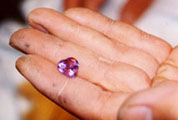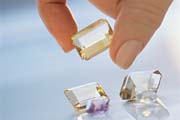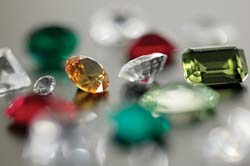|
    


|
Shopping for
gemstones and gemstone jewelry can be confusing. Prices are sometimes very
different for jewelry that appears to be very similar. Some of the
statements in ads are confusing, too, because gemstones are called
natural, genuine, synthetic, simulated, treated—or a combination of those
terms.
It's important for any shopper to understand
gemstone terms before buying any type of gemstone jewelry.
What Are
Natural Gemstones?
Gems brought to
us courtesy of nature, with no interference from humans. By the time they
appear in our jewelry they've been cut or polished, but they've not been
treated or altered in other ways.
What Are
Genuine Gemstones?
Natural
gemstones are genuine gems. So are other stones created by nature, even
the gems that have been treated to enhance their appearance.
They're "real," even if they've been altered in some
way.
Not All
Natural or Genuine Gemstones are Valuable
Don't be fooled into thinking that all natural or genuine
gemstones are desirable or valuable. Small to large stones of poor quality
are common and often considered mining castaways. Get the facts about a
specific gem before you pay a premium price for it.
Smart
Shopping
- Jewelry that includes quality synthetic gems can
be just as beautiful as jewelry made with natural stones—and there are
some great buys out there.
- Good synthetics aren't necessarily inexpensive,
but should cost much less than natural stones of similar quality.
- Since synthetics do have the same composition as
natural stones, they could technically be called "genuine," but that
would be a deceptive label if used alone. A stone's origins should
always be disclosed.
Question the ethics of anyone who knowingly omits
origin information, and the expertise of anyone who cannot provide
it.
Gemstone
and Jewelry Pricing
Like any other
industry, supply and demand drives gemstone prices up and down. For
example,
- Natural rubies of high quality are rare and
demand for them is always high. Some of the areas where topnotch rubies
are mined are in political turmoil, hindering distribution even
more.
- Similarly colored red garnets are gorgeous, but
they aren't rare. A flawless natural garnet costs a great deal less than
a ruby of similar quality.
 |
Be Realistic & Shop Smart
A large percentage of gemstones are treated to enhance
their appearance. The enhancements allow jewelry manufacturers to
improve the appearance of stones that consumers wouldn't otherwise
purchase. Remember, treated gemstones are genuine, but they are no
longer considered natural. |
- Treatments allow more of us to own gemstones. If
naturally "perfect" stones were the only ones available, most of us
couldn't afford them.
- Shopping for a natural gemstone is a lot easier
if it's a color you're after and not a specific stone. Gemstones that
aren't usually treated include garnets, peridot, hematite, alexandrite
and moonstone.
Read as much as you can about gemstones and jewelry,
then study ads carefully to compare prices. Ask for details on all
components, not just the gemstones. Go shopping so that you can compare
jewelry and gemstones side-by-side. But beware if you are a naive. It is
better to trust & go for only those shop where you know the shopkeeper
well.
How
Synthetic Gemstones Differ
A
synthetic gemstone shares a natural stone's physical, chemical and optical
qualities. The difference? Synthetics are created in a laboratory. It's
kind of like making a high tech batch of cookies—we know the ingredients
and we know how long to cook them.
There are synthetic versions of nearly all popular
gemstones and many of them have been around for a long time. Older
synthetics were fairly simple for gemologists to detect—they were often
too perfect. Some modern synthetic gemstones are more difficult to
identify, but an experienced jeweler or gemologist can usually
help.
Stone
Treatments
 |
Turquoise and other natural or mined stones
used in jewelry may have been treated. Treating refers to any
alteration of the properties or appearance of natural turquoise and
other stones, with the exception of cutting and polishing. As per
SinhaGems® business Philosphy, consumers are told if a stone
has been treated and whtether the treatment is temporary/permanent,
and does pricing at true value
only. |
- Dyeing —
adding blue dye to low-grade turquoise, and adding black to gray or pale
blue onyx, to enhance the stone’s appearance.
- Reconstitution — pulverizing fragments
of turquoise, coral or lapis lazuli into powder. The powder is mixed
with epoxy and worked into cakes or stones, which are used just like
natural stones.
- Stabilizing
— Injecting clear, colorless acrylics into low- to medium-grade
turquoise to toughen and harden the stone and enhance its color.
Stabilizing is the most advanced and sophisticated method of treating
turquoise. The majority of turquoise used today is stabilized. Natural
gem-quality turquoise is usually only used by top artists and commands
much higher prices than stabilized turquoise.
It’s not always easy to spot a counterfeit item but price,
materials, appearance, and the seller’s guarantee of authenticity may
help.
|
Gem Buying
Guide
Consider the Gem Alternatives
We recommend buying the best quality
gemstone you can afford. In general, smaller gemstones of higher
quality appreciate more over time than larger stones of lower
quality. If your budget is too small to buy the quality you want,
consider buying a higher quality gemstone from an unusual
variety. |
 |
If your budget is too small to buy the quality you want,
consider buying a higher quality gemstone from an unusual variety.
Mediocre rubies, emeralds and sapphires cost a lot more than fine garnets,
tourmalines, tanzanites, and other exotics.
In general, gemstone pricing within each variety
follows common sense: the more beautiful the gemstone, with the final
visual effect of all the quality factors, the more valuable it is. Don’t
be afraid to choose what looks best to you!
Different varieties have different price ranges.
some varieties are lower in price because they are readily available, some
because the color isn’t very popular (brown and yellow stones, for
example), some because the material is relatively soft, some because they
are too rare to create demand and some because no one has heard of them or
they have a weird name. You think I am kidding? Why does tanzanite cost
more than tsavorite or spinel? A pretty name is the only
explanation.

|
UNDERSTANDING
GEMS
We
can break down the price ranges of the different gem varieties into
five basic categories: Basic Three, New Classics, Connoisseur Gems,
Collector Gemstones and Affordable
Gems.
These categories have basic price ranges. Lower quality
stones, stones with particularly fine quality or color may cost
more. These price ranges are meant to give you a general idea of the
price relationship between the different varieties of
gemstones. |
BASIC THREE OR THE TRADITIONAL GEMSTONES
These are the ruby, the emerald and the blue sapphire.
Because of their lasting appeal and distinguished history, they are
usually more valuable than other colored gemstones.
Generally, rubies and emeralds are priced higher
than a sapphire of comparable quality, due to rarity. For a one-carat
stone of average-to-good quality you can expect to pay between $250 and
$10,000 per carat. Of course, truly fine gems will cost more.
NEW CLASSICS
Then there are
the gemstones that are the rising stars of the jewelry industry:
tanzanite, tourmaline, aquamarine, imperial topaz, and tsavorite garnet.
These gemstones are usually available in standardized sizes, but you
really should look at some of the fine, larger single stones to see why
they have so many fans.
Gems in this category range from $50 to $1,000 per
carat, for an average-to-good-quality one-carat stone. As a perfect
example, tsavorite easily can reach $3,000 per carat.
CONNISEUR GEMS
These are
gemstones that have a more specialized market because they are more of a
rarity. They include black opal, jadeite, pink topaz, chrysoberyl
cat's-eye, fancy colored sapphires, and rare stones like demantoid garnet
and alexandrite, which are practically "extinct" in rough form.
These gemstones are highly prized, with prices that
range from $250 to $5,000 per carat. For instance, an alexandrite with a
good color change will command at least $10,000, even in a one-carat
size.
COLLECTORS ITEMS
These are
not available in quantity to be marketed effectively, so you get a lot of
beauty for the money. This category includes spinels, zircons, moonstones,
morganites and other beryls, along with many other rare gemstones. Red and
hot pink spinels can command a few thousand dollars per carat, but most of
the gems in this category will sell for hundreds, not thousands, even
those specimens with excellent color.
AFFORDABLE GEMS
The more
affordable gems combine great color with surprisingly reasonable prices
and good availability. These stones include some old favorites, as well as
some new ones: amethyst, white opal, citrine, ametrine, peridot, rhodolite
garnet, blue topaz, iolite, chrome diopside, kunzite, andalusite, and many
ornamental gemstones such as lapis lazuli, turquoise, onyx, chrysoprase,
nephrite jade, and amber. Prices for these gemstone range between (Rs.
200/- and Rs. 4000/-) i.e. $5 and $100 per carat for a one-carat
stone.
UNDERSTANDING VALUE
In
every gem variety, especially the more expensive ones, you should expect
to pay more for matched pairs, sets, and special shapes and
cuts.
When you shop for gemstones in jewelry stores you
will see a range in qualities. Generally, you will find low-to-medium
quality gemstones set in jewelry, and a wider range of qualities in unset
gemstones. Often, the jeweler will have to call in top-quality gemstones
from a supplier: most jewelers do not stock a wide selection of fine gems
even in ruby, sapphire and emerald.
How can you comparison-shop on the web? Very
carefully. Some sites make extravagant claims about the "investment
quality" of their stock. With gemstones, color is the most important value
factor; but it's difficult to compare color online, because the
differences between monitors make the color comparison of even the best
photographs difficult.
To counter this effect, the better gem retailers
such as My Jewelz will stock and sell only top-quality gems, because it's
very difficult to show subtle differences in quality on the screen. Also,
a liberal return policy can assure you of the opportunity to independently
appraise your gem in order to verify its quality.
Certainly, lesser-quality and less expensive gems
can be sourced out by retailers who offer finding services. However,
before you decide to trade down in quality, think instead about choosing a
top-quality gemstone in a more unusual gemstone variety.
Remote locations
adverse political conditions
difficult terrain
inhospitable weather
primitive mining techniques
These together made it difficult to make every gemstone available in every terrain. Moreover, heavy taxes, duties & levies making it more costlier. This is why the quality of natural gemstone is depleting by the order of day. And any collectible piece may garner 10 to 50 or more times than its original value then.
|

